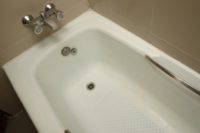Bathtub refinishing chemical kills 13 workers nationwide
Stripping agents, poor ventilation blamed

 Since 2000, at least 13 workers have died in the U.S. after performing bathtub refinishing with stripping agents containing methylene chloride. According to OSHA, in the majority of the cases the workers were working alone, in poorly ventilated bathrooms, with inadequate respiratory protection and little or no training on the hazards of the chemicals they were using.
Since 2000, at least 13 workers have died in the U.S. after performing bathtub refinishing with stripping agents containing methylene chloride. According to OSHA, in the majority of the cases the workers were working alone, in poorly ventilated bathrooms, with inadequate respiratory protection and little or no training on the hazards of the chemicals they were using.
Michigan recently investigated a bathtub-refinishing-related worker fatality through its Fatality Assessment & Control Evaluation (FACE) program and subsequently issued a hazard alert to inform employers and workers. The alert highlights the hazards of working with methylene chloride-based stripping agents, explains safe work practices when using them and lists alternative paint stripping chemicals and processes.
Methylene chloride is a volatile solvent and cancer-causing chemical that is easily absorbed into the body through the lungs and skin. Short-term exposures to high levels of methylene chloride can cause headaches, fatigue, dizziness and lack of coordination. The liver metabolizes methylene chloride to carbon monoxide, and elevated levels of carbon monoxide in the blood can cause heart attacks, irregular heart rhythms and sudden death. OSHA's methylene chloride standard (29 CFR 1910.1052) requires employers to control occupational exposure to methylene chloride through the use of exposure monitoring, engineering and work practices, respiratory protection and medical surveillance.
The agency says it is collaborating with the National Institute for Occupational Safety and Health to develop further guidance for employers and workers in the bathtub refinishing industry.
Looking for a reprint of this article?
From high-res PDFs to custom plaques, order your copy today!






